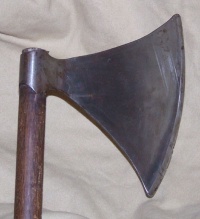Daneaxe: Difference between revisions
Paul Matisz (talk | contribs) No edit summary |
Paul Matisz (talk | contribs) mNo edit summary |
||
| Line 2: | Line 2: | ||
The '''Daneaxe''' (or '''Danish Axe''') was a fearsome, two-handed [[axe]] with a broad, heavy head and a four-to-five-foot haft. The sheer size and weight of this weapon made it one of the most powerful weapons on the field until the development of [[cavalry]]. Handled with skill, the daneaxe could shatter a shield (and likely the arm behind it) with a single blow. [[Armour]] was a poor defense, since [[plate]] armour had not been developed, and, even if [[maille]] withstood the blow, sheer inertia would cause terrible crushing injuries. |
The '''Daneaxe''' (or '''Danish Axe''') was a fearsome, two-handed [[axe]] with a broad, heavy head and a four-to-five-foot haft. The sheer size and weight of this weapon made it one of the most powerful weapons on the field until the development of [[cavalry]]. Handled with skill, the daneaxe could shatter a shield (and likely the arm behind it) with a single blow. [[Armour]] was a poor defense, since [[plate]] armour had not been developed, and, even if [[maille]] withstood the blow, sheer inertia would cause terrible crushing injuries. |
||
Commonly used by [[Dane]]s, [[Viking]]s and Anglo-Saxon]]s, daneaxes were popular weapons up until the advent of mounted cavalry led to the decline of the [[Alfred the Great]]-style [[shieldwall]]. |
Commonly used by [[Dane]]s, [[Viking]]s and [[Anglo-Saxon]]s, daneaxes were popular weapons up until the advent of mounted cavalry led to the decline of the [[Alfred the Great]]-style [[shieldwall]]. |
||
One legend of the [[Battle of Stamford Bridge]] is of the [[berserker]] who, armed with a daneaxe, held the bridge alone, and was only killed when an [[English]] solider [[spear|speared]] him through the planks of the bridge itself, suggesting that no-one could stand against a well-wielded daneaxe, but only defeat it by stealth. |
One legend of the [[Battle of Stamford Bridge]] is of the [[berserker]] who, armed with a daneaxe, held the bridge alone, and was only killed when an [[English]] solider [[spear|speared]] him through the planks of the bridge itself, suggesting that no-one could stand against a well-wielded daneaxe, but only defeat it by stealth. |
||
Revision as of 10:09, 6 May 2007
The Daneaxe (or Danish Axe) was a fearsome, two-handed axe with a broad, heavy head and a four-to-five-foot haft. The sheer size and weight of this weapon made it one of the most powerful weapons on the field until the development of cavalry. Handled with skill, the daneaxe could shatter a shield (and likely the arm behind it) with a single blow. Armour was a poor defense, since plate armour had not been developed, and, even if maille withstood the blow, sheer inertia would cause terrible crushing injuries.
Commonly used by Danes, Vikings and Anglo-Saxons, daneaxes were popular weapons up until the advent of mounted cavalry led to the decline of the Alfred the Great-style shieldwall.
One legend of the Battle of Stamford Bridge is of the berserker who, armed with a daneaxe, held the bridge alone, and was only killed when an English solider speared him through the planks of the bridge itself, suggesting that no-one could stand against a well-wielded daneaxe, but only defeat it by stealth.
